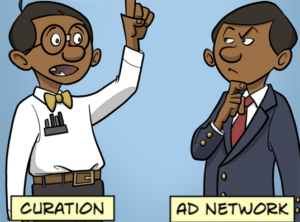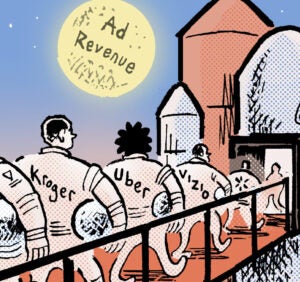 “The Sell-Sider” is a column written by the sell-side of the digital media community.
“The Sell-Sider” is a column written by the sell-side of the digital media community.
Today’s column is written by Jim Spanfeller, CEO at Spanfeller Media Group,
Many argue in this age of deep and big data that content is not nearly as good of a proxy for ad targeting as data. Having both aligned, they’ll say, is of course the best possible solution.
I wholly agree with this second point but want to push back a bit on the first. In my mind, content is the best proxy for what is really important: an advertisement’s ability to have the utmost impact for selling a product or service.
At the end of the day, both content and big data are proxies. They are proxies used to find consumers who are most likely to react favorably to a message and, most importantly, take action as a result.
In the past, we used demography to define the core buyer because, in most cases, that was all we could use. This changed somewhat with the advent of special-interest publishing. Marketers could then find consumers who were expressing huge interest in their products by the media they chose to read or watch, and this is still considered a core practice. In many ways, search is the closest and most tightly aligned “new” tactic in this strategic vein. Someone who is actively looking for information about a product or service is most likely in the market to buy that item.
The obvious issue with this very tightly defined target group is that it is invariably very small compared to the opportunity. There are lots of people who are not actively involved in seeking out specific information about a product or service but who still might, in the near term, consume those things. As a result, marketers look to find other similar attributes around their core customers that can be used to target a wider swath of the population.
Over the years, demography and, to a somewhat lesser extent, psychography have been the main modifiers of this practice. Demography worked and still works well in aligning marketing messages in content environments that are fairly similar to the “special-interest” environments aforementioned. But the inverse is true as well, for a simple reason. Consumers choose for themselves the content by which they want to be entertained and informed. So, in many ways, the content is itself a proxy for the core marketer target.
I argue that content is at least as good of a proxy for marketers as data — if not better. In many ways it offers a dual advantage: It taps into the core consumer mindset and provides the right setting for a message, whereas demography is only one-dimensional.
We have gone down this rabbit hole of audience vs. environment for all sorts of reasons that have little to do with effectiveness. The unintended consequences of this trip have been many and are often not in the best interests of the marketers themselves, such as unsafe brand environments, a higher percentage of unseen advertising and impressions lost to fraud, to name a few. Some level of these issues is found throughout the Web, regardless of how the advertising is targeted, but their intensity is radically higher when one targets for audience alone.
In the end, we all know what the desired outcome is: selling something. Audience and environment are both, to some degree, proxies. Worked together, they can be extremely powerful in putting marketers’ messages in front of the right people at the right time.
Taken apart, when necessary, I would argue that environment is the better of the two for achieving the desired end result. It resonates directly with the consumer’s state of mind, provides a clean atmosphere and acts as a pretty darn good screen for demography.
Follow Jim Spanfeller (@JimSpanfeller) and AdExchanger (@adexchanger) on Twitter.












